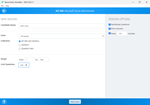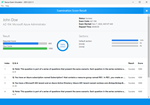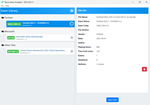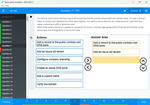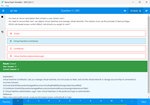Download Certified B2C Solution Architect.Certified-B2C-Solution-Architect.VCEplus.2025-03-25.98q.tqb
| Vendor: | Salesforce |
| Exam Code: | Certified-B2C-Solution-Architect |
| Exam Name: | Certified B2C Solution Architect |
| Date: | Mar 25, 2025 |
| File Size: | 992 KB |
How to open TQB files?
Files with TQB (Taurus Question Bank) extension can be opened by Taurus Exam Studio.
Purchase
Coupon: TAURUSSIM_20OFF
Discount: 20%
Demo Questions
Question 1
A B2C Commerce merchant has multiple live sites across different brands and geographies all supported by Service Cloud and Marketing Cloud. Unfortunately, the merchant is having customer service challenges caused by fragmented views of the customer. Customers occasionally use alternate email addresses, make purchases as guests, and contact customer service anonymously. The Success Manager believes that Customer 360 Data Manager could help them solve their problem.
How should a Solution Architect describe the role of Customer 360 Data Manager in this context?
- Customer 360 Data Manager can be used to recognize customers as humans and extend existing records related to that human across connected systems with a consistent Global Party ID.
- Customer 360 Data Manager can be used to identify multiple records within each separate system representing the same person and assigning them a consistent Global Party ID; additional custom development is thenrequired to relate those IDs between systems.
- Customer 360 Data Manager cannot be used across multiple brands within a single merchant environment because the customer as human view cannot support different accounts under separate brands.
- When Customer 360 Data Manager is provisioned, B2C Commerce, Service Cloud, and Marketing Cloud will automatically use a common core Customer Profile managed by Customer 360 Data Manager.
Correct answer: A
Explanation:
Customer 360 Data Manager is a platform service that enables companies to connect customer data across Salesforce apps and create a unified customer profile. It uses advanced matching algorithms to identify and link customer records from different systems based on common attributes such as name, email, phone, address, etc. It also assigns a consistent Global Party ID to each customer record, which serves as a unique identifier across systems. Customer 360 Data Manager can be used across multiple brands within a single merchant environment by creating separate data spaces for each brand. Option B is incorrect because Customer 360 Data Manager can relate the IDs between systems without additional custom development. Option C is incorrect because Customer 360 Data Manager supports multiple brands within a single merchant environment. Option D is incorrect because B2C Commerce, Service Cloud, and Marketing Cloud do not automatically use a common core Customer Profile managed by Customer 360 Data Manager; they need to be connected and configured via Customer 360 Data Manager.Reference:https://www.salesforce.com/in/blog/2020/04/what-is-salesforce-customer-360.htmlhttps://help.salesforce.com/s/articleView?id=sf.c360_overview.htm&type=5 Customer 360 Data Manager is a platform service that enables companies to connect customer data across Salesforce apps and create a unified customer profile. It uses advanced matching algorithms to identify and link customer records from different systems based on common attributes such as name, email, phone, address, etc. It also assigns a consistent Global Party ID to each customer record, which serves as a unique identifier across systems. Customer 360 Data Manager can be used across multiple brands within a single merchant environment by creating separate data spaces for each brand. Option B is incorrect because Customer 360 Data Manager can relate the IDs between systems without additional custom development. Option C is incorrect because Customer 360 Data Manager supports multiple brands within a single merchant environment. Option D is incorrect because B2C Commerce, Service Cloud, and Marketing Cloud do not automatically use a common core Customer Profile managed by Customer 360 Data Manager; they need to be connected and configured via Customer 360 Data Manager.
Reference:
https://www.salesforce.com/in/blog/2020/04/what-is-salesforce-customer-360.html
https://help.salesforce.com/s/articleView?id=sf.c360_overview.htm&type=5
Question 2
A company actively uses CI/CO processes for their Service Cloud implementation and is adding Marketing Cloud and Marketing Cloud Connect to their architecture. Under the current setup each developer has their own developer sandbox for development. Developers merge their changes into a sandbox for QA regularly, then once every week changes are moved to staging, and from staging to production instances.
Which set up should a Solution Architect propose to support this development approach considering costs and data segregation?
- Set up one Marketing Cloud instance with a business unit for production and one business unit for testing that is connected to all Developer sandboxes
- Set up one Marketing Cloud instance for testing and one for production, where the testing instance is connected to the staging sandbox
- Set up one Marketing Cloud instance for each sandbox in Service Cloud
- Set up one Marketing Cloud instance for production and create a Marketing Cloud sandbox to connect to each of the Service Cloud sandboxes
Correct answer: D
Explanation:
A Marketing Cloud sandbox is a separate instance of Marketing Cloud that can be used for development, testing, and training purposes. A Marketing Cloud sandbox can be connected to a Service Cloud sandbox using Marketing Cloud Connect, which allows data synchronization and cross-cloud functionality. This option supports the CI/CO processes and data segregation for each Service Cloud sandbox. The other options are either not feasible or not cost-effective.Reference:https://help.salesforce.com/s/articleView?id=sf.mc_co_marketing_cloud_sandbox.htm&type=5https://help.salesforce.com/s/articleView?id=sf.mc_co_marketing_cloud_connect.htm&type=5 A Marketing Cloud sandbox is a separate instance of Marketing Cloud that can be used for development, testing, and training purposes. A Marketing Cloud sandbox can be connected to a Service Cloud sandbox using Marketing Cloud Connect, which allows data synchronization and cross-cloud functionality. This option supports the CI/CO processes and data segregation for each Service Cloud sandbox. The other options are either not feasible or not cost-effective.
Reference:
https://help.salesforce.com/s/articleView?id=sf.mc_co_marketing_cloud_sandbox.htm&type=5
https://help.salesforce.com/s/articleView?id=sf.mc_co_marketing_cloud_connect.htm&type=5
Question 3
A company wants to Implement B2C Commerce and Service Cloud and connect the systems with their existing Instance of Marketing Cloud.
Which two tactics should a Solution Architect recommend to model a customer across all three systems? Choose 2 answers
- Migrate the Subscriber Key in Marketing Cloud to be the Service Cloud Contact or Person Account ID.
- Use Customer 360 Data Manager to assign the Global Party ID and use it as a primary key across all systems including the new Subscriber ID in Marketing Cloud.
- Using Service Cloud as a central point hold unique identifiers from all systems including the Service Cloud Contact or Person Account ID and B2C Commerce CustomerNo and Customer ID
- Send the Marketing Cloud Subscriber Key to Service Cloud and B2C Commerce to be held for reference.
Correct answer: AC
Explanation:
Migrating the Subscriber Key in Marketing Cloud to be the Service Cloud Contact or Person Account ID allows for a consistent identification of customers across both systems. This also enables data synchronization and cross-cloud features via Marketing Cloud Connect. Using Service Cloud as a central point to hold unique identifiers from all systems, including B2C Commerce CustomerNo and Customer ID, allows for a single source of truth for customer data and facilitates data integration and reporting across systems. Customer 360 Data Manager is not yet available for B2C Commerce, so option B is not possible. Sending the Marketing Cloud Subscriber Key to Service Cloud and B2C Commerce is not necessary if option A is implemented, so option D is not optimal.Reference:https://help.salesforce.com/s/articleView?id=sf.mc_co_subscriber_key.htm&type=5https://help.salesforce.com/s/articleView?id=sf.mc_co_data_integration_best_practices.htm&type=5https://www.salesforce.com/in/blog/2020/04/what-is-salesforce-customer-360.html Migrating the Subscriber Key in Marketing Cloud to be the Service Cloud Contact or Person Account ID allows for a consistent identification of customers across both systems. This also enables data synchronization and cross-cloud features via Marketing Cloud Connect. Using Service Cloud as a central point to hold unique identifiers from all systems, including B2C Commerce CustomerNo and Customer ID, allows for a single source of truth for customer data and facilitates data integration and reporting across systems. Customer 360 Data Manager is not yet available for B2C Commerce, so option B is not possible. Sending the Marketing Cloud Subscriber Key to Service Cloud and B2C Commerce is not necessary if option A is implemented, so option D is not optimal.
Reference:
https://help.salesforce.com/s/articleView?id=sf.mc_co_subscriber_key.htm&type=5
https://help.salesforce.com/s/articleView?id=sf.mc_co_data_integration_best_practices.htm&type=5
https://www.salesforce.com/in/blog/2020/04/what-is-salesforce-customer-360.html
Question 4
Northern Trail Outfitters (NTO) wants to use Marketing Cloud to implement an Abandoned Cart Solution Workflow so that personalized messages are sent to shoppers who add items to their cart but abandon the B2C Commerce storefront.
Which two options should a Solution Architect recommended to meet this requirement? Choose 2 answers
- Configure streaming updates for catalog importing, implement the Collect Tracking Code, and leverage Journey Builder to trigger an abandoned cart message.
- Configure B2C Commerce catalog, product, order, and customer data feeds; implement Marketing Cloud collect.js and trigger an abandoned cart message through Journey Builder.
- Configure streaming updates for catalog importing, implement Google Analytics tracking, and leverage Journey Builder to trigger an abandoned cart message.
- Configure B2C Commerce catalog, product, inventory, and customer data feeds; implement Marketing Cloud collect.js and trigger an abandoned cart message through Journey Builder.
Correct answer: AB
Explanation:
Both options A and B are valid ways to implement an Abandoned Cart Solution Workflow using B2C Commerce and Marketing Cloud. Option A uses streaming updates for catalog importing, which allows for near real-time updates of product information in Marketing Cloud. Option B uses data feeds that are transferred via SFTP and imported via Automation Studio, which allows for more control over the data format and frequency. Both options use collect.js or Collect Tracking Code to monitor shopper behavior on the B2C Commerce site and share it with Marketing Cloud. Both options also use Journey Builder to trigger personalized messages based on abandoned cart events. Option C is not valid because Google Analytics tracking is not part of the solution. Option D is not valid because inventory data is not required for the solution.Reference:https://help.salesforce.com/s/articleView?id=sf.icx_b2c_abandonedcart_req_workflow.htm&language=en_US&type=5https://trailhead.salesforce.com/content/learn/modules/salesforce-solution-kits-quick-look/c360-sk1 Both options A and B are valid ways to implement an Abandoned Cart Solution Workflow using B2C Commerce and Marketing Cloud. Option A uses streaming updates for catalog importing, which allows for near real-time updates of product information in Marketing Cloud. Option B uses data feeds that are transferred via SFTP and imported via Automation Studio, which allows for more control over the data format and frequency. Both options use collect.js or Collect Tracking Code to monitor shopper behavior on the B2C Commerce site and share it with Marketing Cloud. Both options also use Journey Builder to trigger personalized messages based on abandoned cart events. Option C is not valid because Google Analytics tracking is not part of the solution. Option D is not valid because inventory data is not required for the solution.
Reference:
https://help.salesforce.com/s/articleView?id=sf.icx_b2c_abandonedcart_req_workflow.htm&language=en_US&type=5
https://trailhead.salesforce.com/content/learn/modules/salesforce-solution-kits-quick-look/c360-sk1
Question 5
A Marketing team plans to support the launch of a new product line. In discussion with the Sales and IT teams, the Marketing team proposed introducing a leads-management process, along with a web-to-lead form for the landing page that supports the product launch. The leads captured using the form are added to the new nurturing journey in Marketing Cloud and subsequently routed to the relevant sales team once they qualify at a certain threshold.
What are two implications that a Solution Architect should consider prior to implementing this solution? Choose 2 answers
- Need for additional handling of consent, preferences, and compliance for converted leads in Marketing Cloud
- Engagement history from the lead record will be natively available for contact record in Marketing Cloud
- Leads are unique contact records in Marketing Cloud
- Leads can have detrimental impact on quality of contact records in Sales Cloud
Correct answer: AD
Explanation:
Introducing a leads-management process and a web-to-lead form can have implications for consent, preferences, and compliance for converted leads in Marketing Cloud. For example, if a lead opts out of email communication in Sales Cloud, this preference should be reflected in Marketing Cloud as well. Similarly, if a lead is converted to a contact in Sales Cloud, the corresponding subscriber record in Marketing Cloud should be updated with the new ID and status. Leads can also have a detrimental impact on the quality of contact records in Sales Cloud if they are not properly deduplicated, validated, and enriched. For example, if a lead is createdwith an invalid or duplicate email address, this can affect the deliverability and personalization of email messages in Marketing Cloud.Reference:https://help.salesforce.com/s/articleView?id=sf.mc_co_data_integration_best_practices.htm&type=5https://help.salesforce.com/s/articleView?id=sf.mc_co_subscriber_key.htm&type=5https://help.salesforce.com/s/articleView?id=sf.mc_co_web_to_lead.htm&type=5 Introducing a leads-management process and a web-to-lead form can have implications for consent, preferences, and compliance for converted leads in Marketing Cloud. For example, if a lead opts out of email communication in Sales Cloud, this preference should be reflected in Marketing Cloud as well. Similarly, if a lead is converted to a contact in Sales Cloud, the corresponding subscriber record in Marketing Cloud should be updated with the new ID and status. Leads can also have a detrimental impact on the quality of contact records in Sales Cloud if they are not properly deduplicated, validated, and enriched. For example, if a lead is created
with an invalid or duplicate email address, this can affect the deliverability and personalization of email messages in Marketing Cloud.
Reference:
https://help.salesforce.com/s/articleView?id=sf.mc_co_data_integration_best_practices.htm&type=5
https://help.salesforce.com/s/articleView?id=sf.mc_co_subscriber_key.htm&type=5
https://help.salesforce.com/s/articleView?id=sf.mc_co_web_to_lead.htm&type=5
Question 6
When integrating B2C Commerce with Marketing Cloud, which data extension type should be used to store order and product records in Marketing Cloud?
- Transactional Data Extension
- Standard Data Extension
- Synchronized Data Extension
- Sendable Data Extension
Correct answer: B
Explanation:
A standard data extension is a type of data extension that can store any type of data in Marketing Cloud, including order and product records from B2C Commerce. A standard data extension can be created manually or imported from an external source, such as B2C Commerce. A standard data extension can also be used for segmentation, personalization, and reporting in Marketing Cloud.Reference: https://help.salesforce.com/s/articleView?id=sf.mc_es_data_extensions.htm&type=5 https://help.salesforce.com/s/articleView?id=sf.mc_co_data_integration_with_commerce_cloud.htm&type=5 A standard data extension is a type of data extension that can store any type of data in Marketing Cloud, including order and product records from B2C Commerce. A standard data extension can be created manually or imported from an external source, such as B2C Commerce. A standard data extension can also be used for segmentation, personalization, and reporting in Marketing Cloud.
Reference:
https://help.salesforce.com/s/articleView?id=sf.mc_es_data_extensions.htm&type=5
https://help.salesforce.com/s/articleView?id=sf.mc_co_data_integration_with_commerce_cloud.htm&type=5
Question 7
A company is beginning a multi-cloud implementation involving B2C Commerce and Service Cloud. The company wants to trace configuration and code changes as much as possible and ensure basic standards for code quality.
Which three options should a Solution Architect recommend to help the company with this goal?
Choose 3 answers
- GIT Repository
- Static Code Analysis tools
- CI/CD Pipelines
- Smoke testing
- Salesforce DX
Correct answer: ABC
Explanation:
A GIT repository is a version control system that allows developers to track changes in code and collaborate on projects. A GIT repository can help with tracing configuration and code changes across different environments and branches. Static code analysis tools are software tools that analyze source code or compiled versions of code to find potential errors, bugs, vulnerabilities, or quality issues. Static code analysis tools can help with ensuring basic standards for code quality and security. CI/CD pipelines are automated workflows that enable developers to integrate code changes into a shared repository and deliver them to production environments with speed and reliability. CI/CD pipelines can help with testing, deploying, and monitoring configuration and code changes across different environments. Smoke testing is a type of software testing that verifies the basic functionality of an application or system after deployment. Smoke testing can help with ensuring the stability and performance of configuration and code changes, but it does not trace or enforce them. Salesforce DX is a set of tools and features that enable developers to build applications on the Salesforce Platform using an org development model or a package development model. Salesforce DX can help with managing configuration and code changes across different environments, but it is not specific to multi-cloud implementations.Reference:https://git-scm.com/book/en/v2/Getting-Started-About-Version-Controlhttps://www.perforce.com/blog/qac/what-static-code-analysishttps://www.redhat.com/en/topics/devops/what-is-ci-cdhttps://www.guru99.com/smoke-testing.htmlhttps://developer.salesforce.com/platform/dx A GIT repository is a version control system that allows developers to track changes in code and collaborate on projects. A GIT repository can help with tracing configuration and code changes across different environments and branches. Static code analysis tools are software tools that analyze source code or compiled versions of code to find potential errors, bugs, vulnerabilities, or quality issues. Static code analysis tools can help with ensuring basic standards for code quality and security. CI/CD pipelines are automated workflows that enable developers to integrate code changes into a shared repository and deliver them to production environments with speed and reliability. CI/CD pipelines can help with testing, deploying, and monitoring configuration and code changes across different environments. Smoke testing is a type of software testing that verifies the basic functionality of an application or system after deployment. Smoke testing can help with ensuring the stability and performance of configuration and code changes, but it does not trace or enforce them. Salesforce DX is a set of tools and features that enable developers to build applications on the Salesforce Platform using an org development model or a package development model. Salesforce DX can help with managing configuration and code changes across different environments, but it is not specific to multi-cloud implementations.
Reference:
https://git-scm.com/book/en/v2/Getting-Started-About-Version-Control
https://www.perforce.com/blog/qac/what-static-code-analysis
https://www.redhat.com/en/topics/devops/what-is-ci-cd
https://www.guru99.com/smoke-testing.html
https://developer.salesforce.com/platform/dx
Question 8
A company is In the process of defining the authoritative system for key data entitles Involved In B2C journeys. The company has about 200.000 customers, each averaging 30 orders per year. Which two systems are considered an authoritative system for consent and compliance preferences, as well as primary person attributes such as name, address, birthday, phone, and email?
Choose 2 answers
- B2C Commerce
- Service Cloud
- Experience Cloud
- Marketing Cloud
Correct answer: BD
Explanation:
Service Cloud and Marketing Cloud are considered authoritative systems for consent and compliance preferences, as well as primary person attributes such as name, address, birthday, phone, and email. Service Cloud is the system of record for customer service interactions and case management, and it can store customer consent and preferences for different channels and purposes. Marketing Cloud is the system of record for customer engagement and marketing campaigns, and it can store customer consent and preferences for email, SMS, push notifications, and other channels. B2C Commerce is not an authoritative system for consent and compliancepreferences, as it does not store them natively. It can store some primary person attributes such as name, address, phone, and email, but they may not be the most up-to-date or accurate. Experience Cloud is not an authoritative system for consent and compliance preferences, as it relies on other systems to store them. It can store some primary person attributes such as name, email, and birthday, but they may not be the most up-to-date or accurate.Reference:https://help.salesforce.com/s/articleView?id=sf.mc_co_data_integration_best_practices.htm&type=5https://help.salesforce.com/s/articleView?id=sf.mc_co_data_integration_considerations.htm&type=5 Service Cloud and Marketing Cloud are considered authoritative systems for consent and compliance preferences, as well as primary person attributes such as name, address, birthday, phone, and email. Service Cloud is the system of record for customer service interactions and case management, and it can store customer consent and preferences for different channels and purposes. Marketing Cloud is the system of record for customer engagement and marketing campaigns, and it can store customer consent and preferences for email, SMS, push notifications, and other channels. B2C Commerce is not an authoritative system for consent and compliance
preferences, as it does not store them natively. It can store some primary person attributes such as name, address, phone, and email, but they may not be the most up-to-date or accurate. Experience Cloud is not an authoritative system for consent and compliance preferences, as it relies on other systems to store them. It can store some primary person attributes such as name, email, and birthday, but they may not be the most up-to-date or accurate.
Reference:
https://help.salesforce.com/s/articleView?id=sf.mc_co_data_integration_best_practices.htm&type=5
https://help.salesforce.com/s/articleView?id=sf.mc_co_data_integration_considerations.htm&type=5
Question 9
A company uses Service Cloud and B2C Commerce and now wants to enable the 'Order on Behalf of functionality on its storefront. The customers using the storefront are Person and Household accounts.
Which three design and architecture considerations should a Solution Architect follow to ensure that the 'Order on Behalf of functionality works well for all the designated storefront customers?
Choose 3 answers
- Verify that the permissions used are Login_On_Behalf, Login_Agent, and Create_Order_On_BehaIf_Of business manager functional permissions.
- The Order on Behalf of feature in the Service to B2C Commerce Connector only supports person accounts as a customer model by default.
- Default user is required for anonymous storefront shoppers.
- The REST calls between B2C Commerce and Service Cloud do not count towards API governor limits.
- Verify that agents are Service Cloud and B2C Commerce users with Order on Behalf rights.
Correct answer: ABE
Explanation:
The Order on Behalf of functionality allows Service Cloud agents to create orders for customers on the B2C Commerce storefront. To enable this functionality, the following design and architecture considerations should be followed:Verify that the permissions used are Login_On_Behalf, Login_Agent, and Create_Order_On_BehaIf_Of business manager functional permissions. These permissions are required for the Service Cloud Connector user in B2C Commerce to perform the Order on Behalf of actions.The Order on Behalf of feature in the Service to B2C Commerce Connector only supports person accounts as a customer model by default. If the customers using the storefront are household accounts, additional customization is required to map the household account ID to the B2C Commerce customer ID.Verify that agents are Service Cloud and B2C Commerce users with Order on Behalf rights. Agents need to have both Service Cloud and B2C Commerce user accounts with the appropriate roles and permissions to access the Order on Behalf of feature.Option C is incorrect because a default user is not required for anonymous storefront shoppers. Option D is incorrect because the REST calls between B2C Commerce and Service Cloud do count towards API governor limits.Reference:https://help.salesforce.com/s/articleView?id=sf.icx_b2c_order_on_behalf_of.htm&type=5https://help.salesforce.com/s/articleView?id=sf.icx_b2c_order_on_behalf_of_permissions.htm&type=5https://help.salesforce.com/s/articleView?id=sf.icx_b2c_order_on_behalf_of_limitations.htm&type=5 The Order on Behalf of functionality allows Service Cloud agents to create orders for customers on the B2C Commerce storefront. To enable this functionality, the following design and architecture considerations should be followed:
Verify that the permissions used are Login_On_Behalf, Login_Agent, and Create_Order_On_BehaIf_Of business manager functional permissions. These permissions are required for the Service Cloud Connector user in B2C Commerce to perform the Order on Behalf of actions.
The Order on Behalf of feature in the Service to B2C Commerce Connector only supports person accounts as a customer model by default. If the customers using the storefront are household accounts, additional customization is required to map the household account ID to the B2C Commerce customer ID.
Verify that agents are Service Cloud and B2C Commerce users with Order on Behalf rights. Agents need to have both Service Cloud and B2C Commerce user accounts with the appropriate roles and permissions to access the Order on Behalf of feature.
Option C is incorrect because a default user is not required for anonymous storefront shoppers. Option D is incorrect because the REST calls between B2C Commerce and Service Cloud do count towards API governor limits.
Reference:
https://help.salesforce.com/s/articleView?id=sf.icx_b2c_order_on_behalf_of.htm&type=5
https://help.salesforce.com/s/articleView?id=sf.icx_b2c_order_on_behalf_of_permissions.htm&type=5
https://help.salesforce.com/s/articleView?id=sf.icx_b2c_order_on_behalf_of_limitations.htm&type=5
Question 10
Northern Trail Outfitters (NTO) wants to upgrade its customer service by providing the opportunity for customers to engage using social messaging channels such as Facebook, WhatsApp, and SMS to resolve issues and ask questions. They already use Marketing Cloud Mobile Connect and Social Studio. Alongside these, the Solution Architect also recommends implementing Digita I Engagement features in Service Cloud.
Which two reasons should a Solution Architect use to justify those recommendations?
Choose 2 answers
- Mobile Connect lacks integration with the service agent console without Digital Engagement
- Mobile Connect only supports outbound messaging in selected countries
- Social Studio does not support 1:1 messaging on the apps listed in the scenario
- Social Studio is limited to listening to social channel and not responding
Correct answer: AC
Explanation:
Digital Engagement is a set of features in Service Cloud that enables agents to communicate with customers using social messaging channels such as Facebook, WhatsApp, and SMS. To justify the recommendation of implementing Digital Engagement, a Solution Architect can use the following reasons:Mobile Connect lacks integration with the service agent console without Digital Engagement. Mobile Connect is a feature in Marketing Cloud that allows sending and receiving SMS messages. However, without Digital Engagement, Mobile Connect messages cannot be handled by Service Cloud agents in the service console or omnichannel routing.Social Studio does not support 1:1 messaging on the apps listed in the scenario. Social Studio is a feature in Marketing Cloud that allows listening and engaging with customers on social media platforms. However, Social Studio does not support direct messaging on Facebook or WhatsApp, which are popular social messaging channels.Option B is incorrect because Mobile Connect supports outbound messaging in more than 200 countries. Option D is incorrect because Social Studio can respond to public posts or comments on social media platforms.Reference:https://help.salesforce.com/s/articleView?id=sf.service_digital_overview.htm&type=5https://help.salesforce.com/s/articleView?id=sf.mc_moc_mobileconnect.htm&type=5https://help.salesforce.com/s/articleView?id=sf.mc_moc_supported_countries.htm&type=5https://help.salesforce.com/s/articleView?id=sf.mc_ss_social_studio_overview.htm&type=5 Digital Engagement is a set of features in Service Cloud that enables agents to communicate with customers using social messaging channels such as Facebook, WhatsApp, and SMS. To justify the recommendation of implementing Digital Engagement, a Solution Architect can use the following reasons:
Mobile Connect lacks integration with the service agent console without Digital Engagement. Mobile Connect is a feature in Marketing Cloud that allows sending and receiving SMS messages. However, without Digital Engagement, Mobile Connect messages cannot be handled by Service Cloud agents in the service console or omnichannel routing.
Social Studio does not support 1:1 messaging on the apps listed in the scenario. Social Studio is a feature in Marketing Cloud that allows listening and engaging with customers on social media platforms. However, Social Studio does not support direct messaging on Facebook or WhatsApp, which are popular social messaging channels.
Option B is incorrect because Mobile Connect supports outbound messaging in more than 200 countries. Option D is incorrect because Social Studio can respond to public posts or comments on social media platforms.
Reference:
https://help.salesforce.com/s/articleView?id=sf.service_digital_overview.htm&type=5
https://help.salesforce.com/s/articleView?id=sf.mc_moc_mobileconnect.htm&type=5
https://help.salesforce.com/s/articleView?id=sf.mc_moc_supported_countries.htm&type=5
https://help.salesforce.com/s/articleView?id=sf.mc_ss_social_studio_overview.htm&type=5
HOW TO OPEN VCE FILES
Use VCE Exam Simulator to open VCE files
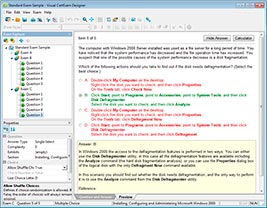
HOW TO OPEN VCEX FILES
Use ProfExam Simulator to open VCEX files
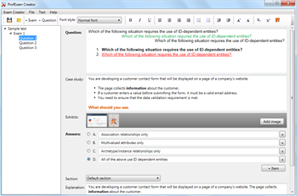
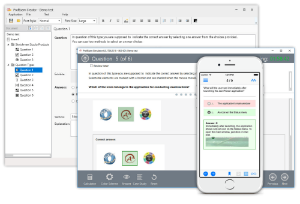
ProfExam at a 20% markdown
You have the opportunity to purchase ProfExam at a 20% reduced price
Get Now!